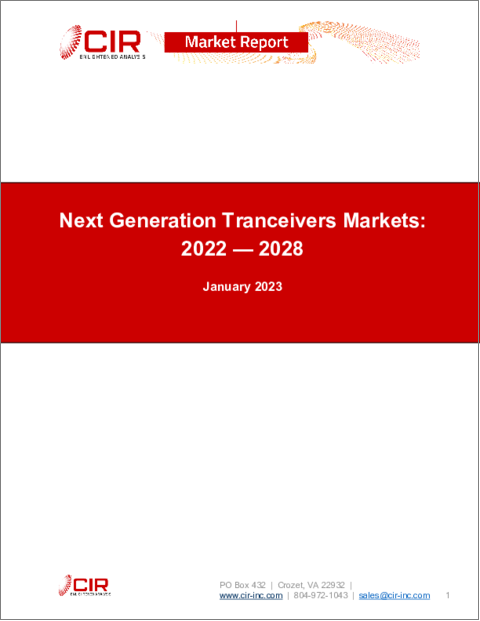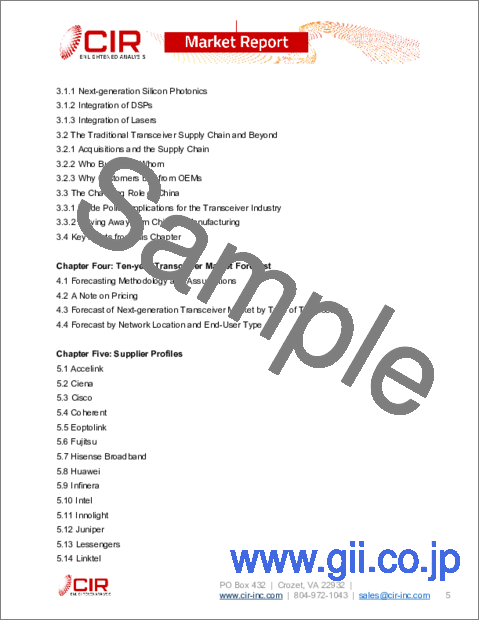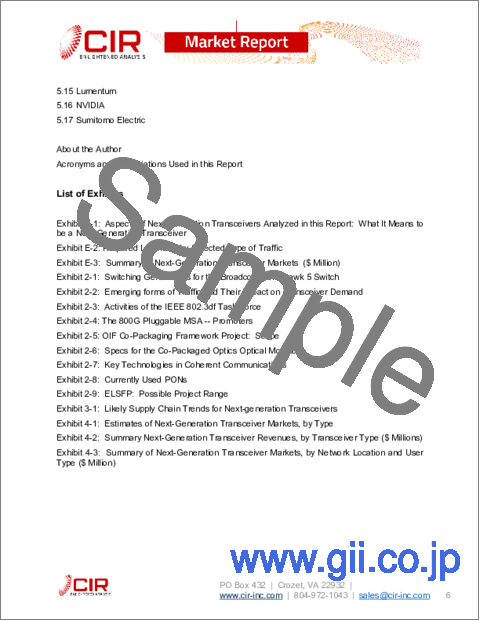|
|
市場調査レポート
商品コード
1152713
次世代トランシーバー市場:2022年~2028年Next Generation Transceivers Markets: 2022-2028 |
||||||
| 次世代トランシーバー市場:2022年~2028年 |
|
出版日: 2023年01月31日
発行: Communications Industry Researchers (CIR)
ページ情報: 英文
納期: 即納可能
|
- 全表示
- 概要
- 目次
当レポートでは、世界の次世代トランシーバー市場について調査し、技術動向、サプライチェーンとマーケティング、10年間の市場予測、および市場に参入する企業のプロファイルなどを提供しています。
目次
エグゼクティブサマリー
第1章 イントロダクション
第2章 トランシーバーおよびトランシーバー市場に影響を与える技術動向
- 影響力のあるトランシーバー市場と製品動向
- 速度の必要性:データレートの増加
- 次世代トランシーバーと次世代トラフィック
- 高度なFECの役割
- 800Gへの移行のためのトランシーバー
- 800GプラガブルMSA
- 搭載光学系
- コパッケージオプティクス
- コヒーレントトランシーバー
- テラビットBiDi MSA
- 次世代PON向けトランシーバー
- トランシーバーとチップ間オプティクス
- 次世代トランシーバの材料関連の側面
- レーザーに関する注意事項
- この章の要点
第3章 トランシーバーの製造、サプライチェーン、およびマーケティングの動向
- 製造と統合
- 従来のトランシーバーサプライチェーン
- 中国の役割の変化
- この章の要点
第4章 10年間のトランシーバー市場予測
第5章 サプライヤーのプロファイル
- Accelink
- Ciena
- Cisco
- Coherent
- Eoptolink
- Fujitsu
- Hisense Broadband
- Huawei
- Infinera
- Intel
- Innolight
- Juniper
- Lessengers
- Linktel
- Lumentum
- NVIDIA
- Sumitomo Electric
著者について
このレポートで使用される頭字語と略語
This report identifies the opportunities for next generation transceivers in data communications and telecommunications. Although the longer-term future of transceivers may be found in co-packaged optics, much of the next-generation transceiver space - consisting of the latest transceivers that are now appearing for the data center, access and metro space - are very much in the pluggable tradition.
Increasingly a transceiver is no longer just a transmitter plus receiver with some simple electronics thrown in. Instead, next-generation transceivers will be smart modules appropriately designed to simplify network architecture and enable more flexible network configurations. These innovations are being designed with an expected surge of high-data rate, latency-sensitive traffic in mind. Pluggability plays an important role in this design work, as will coherent optics and high data rates. The source of such traffic will be AI, machine learning (ML), and virtual reality traffic. Such traffic is only just beginning to appear on the network, but the network is being re-architected today with the traffic of tomorrow clearly in mind and next-generation transceivers.
This report analyzes the technical changes that CIR expects to in transceivers, as well expected changes in the transceiver supply chain. The report begins with a survey of the key emerging technical trends, discussing especially the coming market for 800G pluggables and the spread of coherent communications across the entire network. The report also examines some of the interesting new MSAs that will impact transceiver design going forward and the role that silicon photonics will play. The report is targeted towards OEMs, third-party transceiver suppliers, network managers and, of course, transceiver manufacturers themselves.
Table of Contents
Executive Summary
- E.1. A Definition of Next-generation Transceivers
- E.1.1. Next-Generation Transceivers: Enabling Technologies
- E.2. Traffic Trends Shaping the Next-Generation Transceiver Market
- E.2.1. Latency, Bandwidth and Transceivers
- E.2.2. Types and Evolution of 800G Transceivers
- E.3. The Role of Coherent Communications
- E.3.1. Coherent Transceiver MSAs
- E.4. Next-Generation Transceivers in the Access Network: PONs
- E.5. Manufacturing and Integration
- E.6. Transceiver Supply Chain Transformations
- E.7. Summary of Next-Generation Transceiver Market Forecasts
Chapter One: Introduction
- 1.1. Background to this Report
- 1.2. Objective and Scope of this Report
- 1.3. Plan of this Report
Chapter Two: Influential Technical Trends in Transceivers and the Transceiver Market
- 2.1. Influential Transceiver Market and Product Trends
- 2.2. The Need for Speed: Data Rate Growth
- 2.2.1. Transceivers and Switching Generations
- 2.3. Next-generation Transceivers and Next-generation Traffic
- 2.3.1. AI Services
- 2.3.2. Special Impact of IoT
- 2.3.3. Edge Computing as a Latency Avoidance Strategy
- 2.4. The Role of Advanced FEC
- 2.5. Transceivers for the Transition to 800G
- 2.5.1. 800G Transceivers Based on 400G MSAs-The Work of the Ethernet Consortium
- 2.5.2. IEEE 800G Standards
- 2.5.2.1. The IEEE and 800G
- 2.6. The 800G Pluggable MSA
- 2.6.1. 800G-FR4 Technical Specification
- 2.6.2. 800G-PSM8 Technical Specification
- 2.6.3. 800G-LR-4 Trial
- 2.7. On-Board Optics
- 2.8. Co-packaged Optics
- 2.8.1. The 3.2T Co-Packaged Module
- 2.8.2. Other Variations on CPO
- 2.9. Coherent Transceivers
- 2.9.1. Technology
- 2.9.2. Coherent Optics and DCOs 2
- 2.9.3. ZR Optics
- 2.9.4. 800G-LR
- 2.9.5. XR Optics and the Open XR Forum
- 2.9.6. Applications for Coherent Transceivers
- 2.10. Terabit BiDi MSA
- 2.11. Transceivers for Next-generation PONs
- 2.11.1. Transceivers and the PON Difference
- 2.11.2. Current Generations of PON Transceivers
- 2.11.3. The Future of PON Transceivers
- 2.12. Transceivers and Chip-to-Chip Optics
- 2.13. Materials-related Aspects of Next-Generation Transceivers
- 2.13.1. Plasmonic Transceivers
- 2.13.2. Graphene Transceivers
- 2.14. Some Notes on Lasers
- 2.14.1. Traditional Transceiver Lasers
- 2.14.2. Intel and Transceiver Lasers
- 2.14.3. External Laser Small Form Factor (ELSP) Pluggable Project
- 2.14.4. Quantum Dot Lasers
- 2.15. Key Points from this Chapter
Chapter Three: Trends in Transceiver Manufacturing, Supply Chains and Marketing
- 3.1. Manufacturing and Integration
- 3.1.1. Next-generation Silicon Photonics
- 3.1.2. Integration of DSPs
- 3.1.3. Integration of Lasers
- 3.2. The Traditional Transceiver Supply Chain and Beyond
- 3.2.1. Acquisitions and the Supply Chain
- 3.2.2. Who Buys from Whom
- 3.2.3. Why Customers buy from OEMs
- 3.3. The Changing Role of China
- 3.3.1. Trade Policy Implications for the Transceiver Industry
- 3.3.2. Moving Away from Chinese Manufacturing
- 3.4. Key Points from this Chapter
Chapter Four: Ten-year Transceiver Market Forecast
- 4.1. Forecasting Methodology and Assumptions
- 4.2. A Note on Pricing
- 4.3. Forecast of Next-generation Transceiver Market by Type of Transceivers
- 4.4. Forecast by Network Location and End-User Type
Chapter Five: Supplier Profiles
- 5.1. Accelink
- 5.2. Ciena
- 5.3. Cisco
- 5.4. Coherent
- 5.5. Eoptolink
- 5.6. Fujitsu
- 5.7. Hisense Broadband
- 5.8. Huawei
- 5.9. Infinera
- 5.10. Intel
- 5.11. Innolight
- 5.12. Juniper
- 5.13. Lessengers
- 5.14. Linktel
- 5.15. Lumentum
- 5.16. NVIDIA
- 5.17. Sumitomo Electric
About the Author
Acronyms and Abbreviations Used in this Report
List of Exhibits
- Exhibit E-1: Aspects of Next-generation Transceivers Analyzed in this Report: What It Means to be a Next-Generation Transceiver
- Exhibit E-2: Required Latencies by Selected Type of Traffic
- Exhibit E-3: Summary of Next-Generation Transceiver Markets ($ Million)
- Exhibit 2-1: Switching Generations for the Broadcom Tomahawk 5 Switch
- Exhibit 2-2: Emerging forms of Traffic and Their Impact on Transceiver Demand
- Exhibit 2-3: Activities of the IEEE 802.3df Task Force
- Exhibit 2-4: The 800G Pluggable MSA -- Promoters
- Exhibit 2-5: OIF Co-Packaging Framework Project: Scope
- Exhibit 2-6: Specs for the Co-Packaged Optics Optical Module
- Exhibit 2-7: Key Technologies in Coherent Communications
- Exhibit 2-8: Currently Used PONs
- Exhibit 2-9: ELSFP: Possible Project Range
- Exhibit 3-1: Likely Supply Chain Trends for Next-generation Transceivers
- Exhibit 4-1: Estimates of Next-Generation Transceiver Markets, by Type
- Exhibit 4-2: Summary Next-Generation Transceiver Revenues, by Transceiver Type ($ Millions)
- Exhibit 4-3: Summary of Next-Generation Transceiver Markets, by Network Location and User Type ($ Million)




